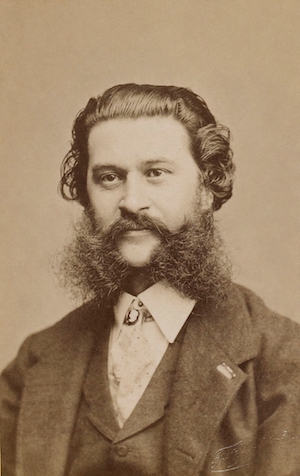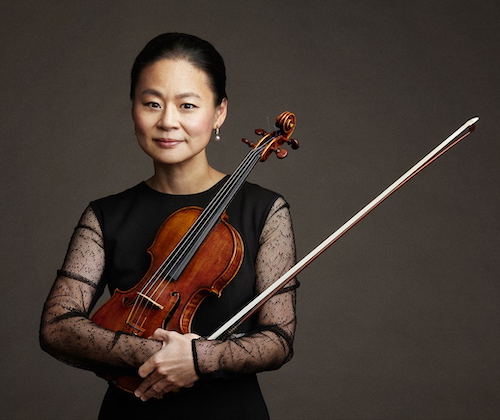by Jarrett Hoffman

•Today: Cleveland Chamber Symphony highlights emerging composers, CMA presents Le Poème Harmonique in music that would have been heard by a young Louis XIV, and pianist Gerardo Teissonnière is featured in a CIM faculty recital
•Announcements: a musicological article by BW graduate Chase Castle, young people’s concerts from the Canton Symphony, and a survey from the Ohio Arts Council
•Interesting reads: a new documentary about Fanny Mendelssohn and how her talents were kept quiet
•Almanac: Strauss Jr.’s Blue Danube, Bizet’s Carmen, and the many sides of Midori
HAPPENING TODAY:
At 7:00 at Baldwin Wallace’s Gamble Auditorium, Steven Smith leads the Cleveland Chamber Symphony in a free concert of music by seven of the area’s young and emerging composers: Benjamin Brody (University of Akron), Julia Grady (Baldwin Wallace), Adam Har-zvi (Bowling Green), Gabriel Stossel (CIM), Alexandra Vaduva (Cleveland State), Haider Riaz (Kent State), and Jake Berran (Oberlin). You can also watch a free livestream here.
At 7:30 at Gartner Auditorium, the CMA Performing Arts Series presents Le Poème Harmonique (pictured) in “Music for a Young King,” which explores music that would have been heard in the court of young Louis XIV, including traditional French chansons, works by Moulinié, de Lalande, and Charpentier, and excerpts from the first operas performed in France by Lully and Cavalli. Tickets are available online.
Also at 7:30, at Mixon Hall, a CIM Faculty Recital will feature pianist Gerardo Teissonnière in Schubert’s Four Impromptus and Beethoven’s Piano Sonata No. 32 in c. It’s free but reservations are required.
ANNOUNCEMENTS:

“This article examines the political function of hymns on southern antebellum plantations,” explains Castle, who is now a Benjamin Franklin Fellow and PhD candidate in Music at the University of Pennsylvania. “I use the term ‘sonic domination’ to describe how white slaveowners maintained an aural landscape and explain the ways in which enslaved African Americans circumvented the oppressive power of the planter elite through hymnody.” Read the article here from Cambridge University Press.
The Canton Symphony presents a young people’s program titled “Cooking with Sound” — exploring how the sections of an orchestra are similar to different tasks in a restaurant kitchen — today and tomorrow, October 25 and 26 at 9:45 and 11:00 am in Umstattd Hall at Zimmermann Symphony Center. Register here.
The Ohio Arts Council seeks feedback from Ohio residents in a statewide survey on arts and culture (and as a bonus, participants are entered to win $50). Take the survey here.
INTERESTING READS:
The great-great-great granddaughter of Fanny Mendelssohn has made a new documentary examining how the talents of that composer “were kept as quiet as possible” while her brother Felix Mendelssohn was celebrated. “Music will perhaps become his profession, whilst for you it can and must only be an ornament, never the root of your being and doing,” her father wrote to her when she was 14. Click here to read an article in The Guardian by the maker of the documentary, Sheila Hayman.
TODAY’S ALMANAC:

Strauss Jr. (pictured), that king of the waltz, is a composer whose music is widely known even among those who don’t know his name, thanks to ubiquitous pieces such as The Blue Danube. And there’s a reason for that ubiquitousness — gosh darn is it charming.
So closely associated with Austria, it’s considered an unofficial national anthem. And speaking of Austrians — Franz Welser-Möst leads the Vienna Philharmonic in a Blue Danube performance here.
Fun fact: the piece was originally written for choir, with a text by poet Joseph Weyl of the Vienna Men’s Choral Association, the group that gave the premiere. The ubiquitous — dare me to use that word again — instrumental version was an adaptation that Strauss made a year later, for the 1867 World’s Fair. Listen to a performance by the Vienna Boys Choir here.
Speaking of ubiquitous, it might surprise you to learn that Bizet’s Carmen — his final work, written three months before his death at age 36 — was initially panned. Critics in Paris struggled to reconcile it with their expectations of something lighter and more Offenbach-esque (the work’s two librettists had worked on many of that composer’s operettas) or something more in line with Wagner. Here’s a quote from one review that has aged very well, describing the music as “dull and obscure,” adding, “the ear grows weary of waiting for the cadence that never comes.”
Nor was the general populace particularly enthused, as evidenced by half-empty audiences — though interest picked up after Bizet’s death, which came the day following the 33rd performance. And when the opera was revived soon afterwards in Vienna, things really started to turn around for its popularity. Click here to watch Maria Callas sing the “Habanera” live in Hamburg in 1962.
Carmen is a useful transition to Midori — at the age of 16, she performed Sarasate’s Carmen Fantasy with Seiji Ozawa and the Boston Symphony, part of a birthday celebration for Leonard Bernstein. Watch here.
Born a child prodigy, Midori made her public debut at the age of six. Her choice of repertoire? One of Paganini’s famously difficult Caprices, of course. By her mid-teens, having just graduated from Juilliard Pre-College and moved into a full-time professional career, she already had a glittering resume, including performances with Zubin Mehta and the New York Philharmonic, and with Bernstein at Tanglewood.
As Michael Zwiebach writes in San Francisco Classical Voice, the years since have seen the violinist “deepen her artistry and repertory, found a nonprofit for educating underserved children in the U.S. and Japan in classical music, earn a master’s degree in psychology from NYU in 2005, while still performing, and become a highly beloved teacher” — she’s currently on the faculties of both USC and Curtis. She has also written a memoir, although it hasn’t yet been translated from German to English. (Someone out there, hop to it!)
Zwiebach also selects highlights from Midori’s extensive discography in that article, titled “The Essential Midori.” One recommendation: her 2017 performance of the Chaconne from Bach’s Partita No. 2, in a very fitting place. You’ll find out when you see it.




